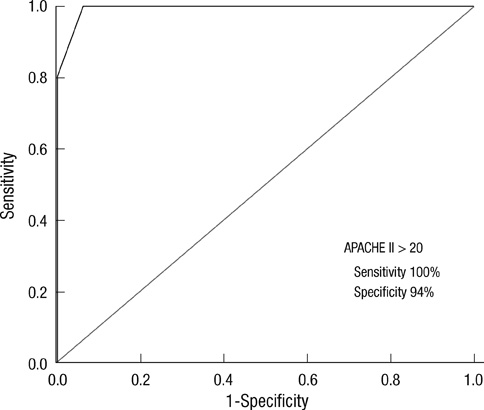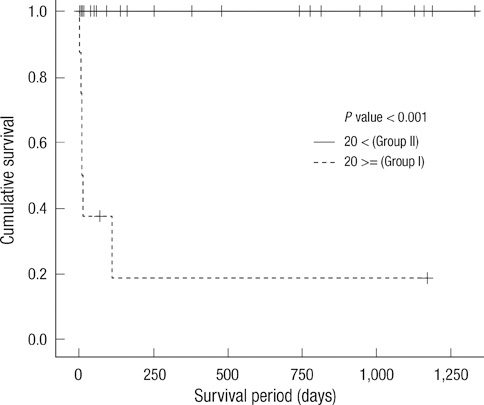J Korean Med Sci.
2012 Jan;27(1):52-57. 10.3346/jkms.2012.27.1.52.
APACHE II Score, Rather Than Cardiac Function, May Predict Poor Prognosis in Patients With Stress-Induced Cardiomyopathy
- Affiliations
-
- 1Department of Internal Medicine, Kyung-Hee University, School of Medicine, Seoul, Korea. chongjinkim0316@yahoo.co.kr
- 2Department of Cardiology, Incheon Sarang Hospital, Inchon, Korea.
- KMID: 1792979
- DOI: http://doi.org/10.3346/jkms.2012.27.1.52
Abstract
- While the disease course of stress-induced cardiomyopathy (SIC) is usually benign, it can be fatal. The prognostic factors to predict poorer outcome are not well established, however. We analyzed the Acute Physiology And Chronic Health Evaluation (APACHE) II score to assess its value for predicting poor prognosis in patients with SIC. Thirty-seven consecutive patients with SIC were followed prospectively during their hospitalization. Clinical factors, including APACHE II score, coronary angiogram, echocardiography and cardiac enzymes at presentation were analyzed. Of the 37 patients, 27 patients (73%) were women. The mean age was 66.1 +/- 15.6 yr, and the most common presentation was chest pain (38%). Initial echocardiographic left ventricular ejection fraction (EF) was 42.5% +/- 9.3%, and the wall motion score index (WMSI) was 1.9 +/- 0.3. Six patients (16%) expired during the follow-up period of hospitalization. Based on the analysis of characteristics and clinical factors, the only predictable variable in prognosis was APACHE II score. The patients with APACHE II score greater than 20 had tendency to expire than the others (P = 0.001). Based on present study, APACHE II score more than 20, rather than cardiac function, is associated with mortality in patients with SIC.
MeSH Terms
Figure
Cited by 1 articles
-
Different Characteristics between Patients with Apical and Non-Apical Subtypes of Stress-Induced Cardiomyopathy
Sun Hwa Lee, Won Ho Kim, Sang Rok Lee, Kyung Suk Rhee, Jei Keon Chae, Jae Ki Ko
J Cardiovasc Ultrasound. 2013;21(3):116-122. doi: 10.4250/jcu.2013.21.3.116.
Reference
-
1. Kawai S, Kitabatake A, Tomoike H. Takotsubo Cardiomyopathy Group. Guidelines for diagnosis of takotsubo (ampulla) cardiomyopathy. Circ J. 2007. 71:990–992.2. Bybee KA, Kara T, Prasad A, Lerman A, Barsness GW, Wright RS, Rihal CS. Systematic review: transient left ventricular apical ballooning: a syndrome that mimics ST-segment elevation myocardial infarction. Ann Intern Med. 2004. 141:858–865.3. Tsuchihashi K, Ueshima K, Uchida T, Oh-mura N, Kimura K, Owa M, Yoshiyama M, Miyazaki S, Haze K, Ogawa H, Honda T, Hase M, Kai R, Morii I. Angina Pectoris-Myocardial Infarction Investigations in Japan. Transient left ventricular apical ballooning without coronary artery stenosis: a novel heart syndrome mimicking acute myocardial infarction. Angina Pectoris-Myocardial Infarction Investigations in Japan. J Am Coll Cardiol. 2001. 38:11–18.4. Sharkey SW, Lesser JR, Zenovich AG, Maron MS, Lindberg J, Longe TF, Maron BJ. Acute and reversible cardiomyopathy provoked by stress in women from the United States. Circulation. 2005. 111:472–479.5. Akashi YJ, Goldstein DS, Barbaro G, Ueyama T. Takotsubo cardiomyopathy: a new form of acute, reversible heart failure. Circulation. 2008. 118:2754–2762.6. Sharkey SW, Windenburg DC, Lesser JR, Maron MS, Hauser RG, Lesser JN, Haas TS, Hodges JS, Maron BJ. Natural history and expansive clinical profile of stress (tako-tsubo) cardiomyopathy. J Am Coll Cardiol. 2010. 55:333–341.7. Knaus WA, Draper EA, Wagner DP, Zimmerman JE. APACHE II: a severity of disease classification system. Crit Care Med. 1985. 13:818–829.8. Hahn JY, Gwon HC, Park SW, Choi SH, Choi JH, Choi JO, Lee SC, On YK, Kim JS, Kim DK, Jeon ES, Lee SH, Hong KP, Park JE. The clinical features of transient left ventricular nonapical ballooning syndrome: comparison with apical ballooning syndrome. Am Heart J. 2007. 154:1166–1173.9. Lee HH, Gwon HC, Kim BJ, Lee KJ, Im ES, Won KH, Sung JD, Lee SC, Park SW, Kim DK, Lee SH, Seo JD. Clinical manifestation of novel stress-induced cardiomyopathy mimicking acute myocardial infarction: single center prospective registry. Korean Circ J. 2002. 32:1054–1063.10. Dib C, Asirvatham S, Elesber A, Rihal C, Friedman P, Prasad A. Clinical correlates and prognostic significance of electrocardiographic abnormalities in apical ballooning syndrome (Takotsubo/stress-induced cardiomyopathy). Am Heart J. 2009. 157:933–938.11. Lee PH, Song JK, Sun BJ, Choi HO, Seo JS, Na JO, Kim DH, Song JM, Kang DH, Kim JJ, Park SW. Outcomes of patients with stress-induced cardiomyopathy diagnosed by echocardiography in a tertiary referral hospital. J Am Soc Echocardiogr. 2010. 23:766–771.
- Full Text Links
- Actions
-
Cited
- CITED
-
- Close
- Share
- Similar articles
-
- Comparing the Usefulness of the Initial Acute Physiologic and Chronic Health Evaluation (APACHE) II Score in the Emergency Department (ED) and the Mortality in Emergency Department Sepsis (MEDS) Score for Predicting the Prognosis of Septic Patients Admitt
- Gender Differences in Clinical Profiles of Stress-Induced Cardiomyopathy
- Relationships between APACHE II and APACHE III Scores and Mortality Rate in Intensive Care Unit Patients
- APACHE II Score and Multiple Organ Failure Score as Predictors of Mortality Rate of Critically Ill Patients
- Stress-Induced Cardiomyopathy: Assessment with Cardiac Magnetic Resonance Imaging and Multi-Detector Computed Tomography



